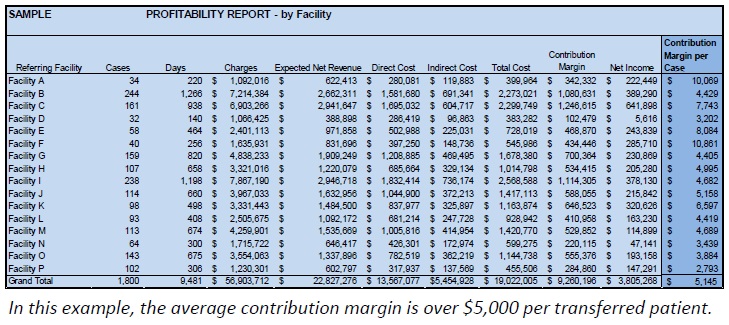
The Problem – Across the nation, health systems are reporting a sustained decline in Emergency Department utilization, resulting in decreased admission rates and reduced patient days. Regardless of the cause (Healthcare Reform, economic challenges, rising unemployment, etc.), the impact is clear – an average 3-5% drop in census and a significant loss of revenue.
The Emergency Department Imperative – On average, 12-15% of Emergency Department visits result in patients being admitted, which accounts for approximately 40-50% of a facility’s total admissions, and a contribution margin between $1k - $15k per admit. The direct connection between Emergency Department utilization, subsequent admissions and the resulting revenue indicates that the success of any facility in this changing healthcare landscape depends on increasing the number of times that new patients pass through the Emergency Department doors. Health systems operating Trauma Centers will have contribution margins exceeding the national average.
The Million Dollar Question – Understanding the concept of countering a declining census by increasing Emergency Department utilization is easy, but successfully operationalizing that strategy may not be. Simply put, how does one hospital or health system get more patients into their Emergency Departments than another? Although there are many potential answers to that question, experience shows that the most effective solution is for a facility or health system to develop a highly functional Regional Referral Program.
The Regional Referral Solution – Health systems should be able to successfully capitalize on its current Trauma status and market itself as regional destination, which will significantly increase patient admissions. A key to success will be aligning referring facilities, physicians, and transport providers through an efficient Transfer Center operation. Your organization will be able to benefit from those opportunities. Additionally, current successes show that facilities and health systems that have implemented Regional Referral Programs have grown their influence significantly garnering patient care and admission opportunities from facilities far outside of traditional referral patterns. This has proven beneficial because the payor mix of patients being referred from out-of-area tend to be equal to or better than the receiving facility’s current Emergency Department mix, resulting in a 15 to 1 return on investment.
Regional Referral Program Priorities – Numerous successful hospitals and health systems have developed very effective Regional Referral Programs by prioritizing the following:
Identification and Development of Key Service Lines – Determining which specialties (Trauma, Cardiology, Neurology, Pediatrics, etc.) the facility wishes to specifically solicit patients for. The goal is to develop a solid reputation as the “go to” receiving facility for the targeted service lines.
Aligning Physician Partners – The success of any Regional Referral Program depends on the participation and support of the facility’s physician partners, whether by promoting the program with regular visits to the region’s referring facilities, or by being consistently available and accepting patients. To achieve this, successful Regional Referral Programs have implemented effective Hospitalist Programs to receive the patients and specialist compensation programs that reward participation.
Transfer Center Utilization and Marketing – Effective Regional Referral Programs require three primary components; necessary specialties, physician participation, and a simple, consistent way for facilities to refer their patients. Structured Transfer Centers tie the entire referral program together with “one call does it all” ease, coordinating patient transfers from the initial request through completion of the transport. Mature Transfer Centers will also provide extensive operational reporting and key patient flow analytics for hospital administration. Focused marketing strategies can also convert the Transfer Center from a passive patient flow processing service into an aggressive volume builder for the facility or health system. Proven techniques can be employed to grow desired business through sound relationships with the referring parties.
Note: There are generally two methods of implementing a Transfer Center service; a facility can develop the service in-house or they can seek out a professional third-party Transfer Center service provider. An internal Transfer Center allows the facility or health system to maintain strict control of the staffing, customer interactions and processes, but a professional external Transfer Center will generally provide outstanding service delivery at a fraction of the cost.
Regional Referral programs are showing exceptional returns in the form of increased Contribution Margins per referral. The chart below – based on actual Regional Referral Programs – highlights the benefits:

Transfer Center Costs – Studies of current successful internal Transfer Center services show that the average cost per transfer request is approximately $230 for new centers and $190 for established centers (assuming a daily request volume of ~12). For facilities or health systems that prefer to forego the expense and coordination of operating their own Transfer Centers in favor of utilizing the expertise of a professional external service, the cost is obviously significantly lower – with no associated reduction in the contribution margin per transferred patient.
Conclusion – For hospitals or health systems seeking to counter the downward trend in Emergency Department utilization and subsequent census declines, it is essential that they develop a Regional Referral Program. By establishing themselves as “centers of excellence” in key service lines, partnering with their physician specialists, and easily facilitating patient flow through efficient Transfer Centers, facilities can continue to thrive even in today’s constantly shifting healthcare environment.
Solution - We can provide a comprehensive assessment of the opportunity for your organization to expand your market as a Regional Referral Center with a state of the art Transfer Center.
✔ Current situation
✔ Market potential for referrals
✔ Business plan for the recommended approach with a Return on Investment analysis
✔ Sensitive issues
✔ Hospital capacity readiness
✔ Medical Staff readiness
✔ Hospitalist Program effectiveness
✔ Case management strategies
✔ Nursing coordination
✔ Administrative and Medical Leadership buy-in
Please let us know if you would like to explore the assessment of the potential for your health system. We look forward to possibly assisting you with this important project.
Thank you,
This email address is being protected from spambots. You need JavaScript enabled to view it.
Connect with us on LinkedIn and join our Active Network Program.